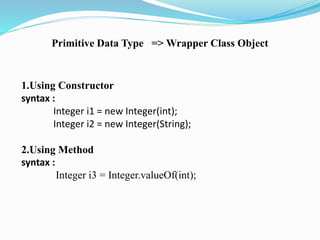Java String
- 1. Wrapper Classes And String Satyam Shrivastav
- 3. Primitive Data Type => Wrapper Class Object 1.Using Constructor syntax : Integer i1 = new Integer(int); Integer i2 = new Integer(String); 2.Using Method syntax : Integer i3 = Integer.valueOf(int);
- 4. Wrapper Class Object => Primitive Data Type 1.Using method xxxValue() syntax : Integer io=Integer.valueOf(254) int i=io.xxxValue();
- 5. Primitive String Object => Wrapper Class Object 1.Using Constructor syntax : Integer i1 = new Integer(“primitiveType”); 2.using method syntax : Integer i1=Integer.valueOf(“primitiveType”);
- 6. Primitive String Object => Primitive Data Type //1.Primitive String Object =>Primitive String Object => Primitive Data Type //2Primitive String Object => Primitive Data Type Using method parseInt(“primitive type”); syntax : String s1=Integer.parseInt(“100”)
- 7. Wrapper Class Object => String Object 1.using method toString() syntax : Integer io=new Integer(254); String s=io.toString()
- 8. Primitive Data Type => Non String Object 1.using method toString(primitive type) syntax : String s=Integer.toString(10);
- 9. String
- 10. String String is a sequence of characters placed in double quote(“ ”). Strings are constant , their values cannot be changed in the same memory after they are created.
- 11. How to create String object There are two ways to create String object: 1)By string literal. 2)By new keyword. 1)By string literal: For Example: String s1=“welcome"; String s2=“welcome”; //no new object will be created
- 12. 2) By new keyword:- For Example: String s=new String(“Sachin"); String s=new String(“SachinTendulkar");//create two objects and one reference variable.
- 13. Immutability • In java, string objects are immutable. Immutable simply means unmodifiable or unchangeable. • Once string object is created its data or state can't be changed but a new string object is created.
- 14. Advantages Of Immutability Use less memory: String word1 = "Java"; String word2 = word1; String word1 = “Java"; String word2 = new String(word1); word1 OK Less efficient: wastes memory Java Java Java word2 word1 word2
- 15. Disadvantages of Immutability Less efficient — you need to create a new string and throw away the old one even for small changes. Example: String word = “Java"; word= word.concat(“technologies”); word Java Java technologies
- 16. Constructors No Argument Constructors: No-argument constructor creates an empty String. Rarely used. Example: String empty=new String(); Copy Constructors: Copy constructor creates a copy of an existing String . Also rarely used. Example: String word = new String(“Java”); String word2 = new String(word); Other Constructors: Most other constructors take an array as a parameter to create a String. Example: char[] letters = {‘J’, ‘a’, ‘v’, ‘a’}; String word = new String(letters);//”Java”
- 17. String Methods substring(int begin): Returns substring from begin index to end of the String. Example: String s=“nacre”; System.out.println(s.substring(2));//cre equals(): To perform content comparision where case is important. Example: String s=“java”; System.out.println(s.equals(“java”));//true concat(): Adding two strings we use this method Example: String s=“nacre”; s= s.concat(“software”); System.out.println(s);// nacresoftware
- 18. length() , charAt() int length(); char charAt(i); Returns the number of characters in the string Returns the char at position i. Character positions in strings are numbered starting from 0 – just like arrays. Returns: “Problem".length(); 7 “Window”. charAt (2); ’n'
- 19. New features of String In 1.5 Version: Wrapper classes are introduced. Example. String s = Integer.toString(10); System.out.println(s);//10 In 1.7 Version: Java 7 extended the capability of switch case to use Strings also, earlier java versions doesn’t support this. If you are implementing conditional flow for Strings, you can use if-else conditions and you can use switch case if you are using Java 7 or higher versions.
- 21. Limitation of String in Java ? What is mutable string? A string that can be modified or changed is known as mutable string. StringBuffer and StringBuilder classes are used for creating mutable string. Differences between String and StringBuffer in java? Main difference between String and StringBuffer is String is immutable while StringBuffer is mutable
- 22. Relations between StringBuffer, StringBuilder and StringToknizer: All These classes are final and subclass of Serializable.
- 23. StringBuffer StringBuffer is a synchronized and allows us to mutate the string. StringBuffer has many utility methods to manipulate the string. This is more useful when using in a multithreaded environment. Always modified in same memory location.
- 24. StringBuffer Constructor: 1. public StringBuffer() 2. public StringBuffer(int capacity) 3. public StringBuffer(String s) 4. public StringBuffer(CharSequence cs)
- 25. Method Use In StringBuffer 1. Append 2. Insert 3.Delete 4.Reverse 5.Replacing Character at given index
- 26. StringBuilder StringBuilder is the same as the StringBuffer class The StringBuilder class is not synchronized and hence in a single threaded environment, the overhead is less than using a StringBuffer.
- 27. StringTokenizer A token is a portion of a string that is separated from another portion of that string by one or more chosen characters (called delimiters). The StringTokenizer class contained in the java.util package can be used to break a string into separate tokens. This is particularly useful in those situations in which we want to read and process one token at a time; the BufferedReader class does not have a method to read one token at a time
- 28. Thank you…
















![Constructors
No Argument Constructors:
No-argument constructor creates an empty String. Rarely used.
Example: String empty=new String();
Copy Constructors:
Copy constructor creates a copy of an existing String . Also rarely used.
Example: String word = new String(“Java”);
String word2 = new String(word);
Other Constructors:
Most other constructors take an array as a parameter to create a String.
Example: char[] letters = {‘J’, ‘a’, ‘v’, ‘a’};
String word = new String(letters);//”Java”](https://image.slidesharecdn.com/string-141110045404-conversion-gate01/85/Java-String-16-320.jpg)











